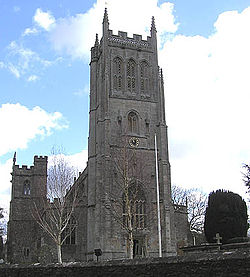Church of St Mary, Bruton
| Church of St Mary | |
|---|---|
 |
|
| Location | Bruton, Somerset, England |
| Coordinates | 51°06′42″N 2°27′07″W / 51.11167°N 2.45194°WCoordinates: 51°06′42″N 2°27′07″W / 51.11167°N 2.45194°W |
| Built | 14th century |
|
Listed Building – Grade I
|
|
| Designated | 24 March 1961 |
| Reference no. | 261663 |
The Church of St Mary in Bruton, Somerset, England was largely built in the 14th century. Like many Somerset churches, it has a very fine tower; less usually it has a second one as well. It has been designated a Grade I listed building.
The first church on the site was founded by Ine of Wessex in the 7th century, which grew into an Augustinian priory, becoming Bruton Abbey shortly before the Dissolution of the Monasteries. The church was within the grounds of the abbey so strictly a chapel of it, but always in effect the parish church of the town, with an office and what was perhaps a schoolroom in the north tower above the porch.
The Bruton branch of the Berkeley family have a long association with the town and the church. William Berkeley left Bruton for America becoming colonial governor of Virginia. The church has links with Bruton Parish Church in the restored area of Colonial Williamsburg in Williamsburg, Virginia, USA.
It has two towers, the larger of which dates from after 1485, and is the furthest south of a type called the "Mendip towers". It houses the oldest bell in Somerset, dating from 1528. It is 102.5 feet (31.2 m) high. This is the west tower; the older north tower is unusually placed over the church porch.
The north aisle and tower, and the crypt under the chancel, date back to the early 14th century and are the oldest remaining parts of the church, followed by the south aisle and then the early 15th-century nave. The clerestory and roof are from 1506-1523, and the former screen, now by the north tower, Jacobean of 1620. The chancel was rebuilt in 1743 by Nathaniel Ireson for Sir Charles Berkeley as a shallow tunnel vault with Rococo styling, another unexpected note.
...
Wikipedia

